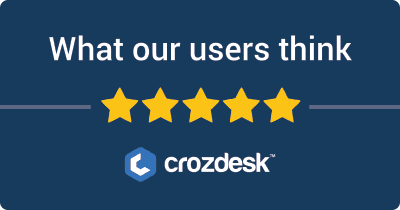
Top Google Forms Alternatives & Competitors based on 75 Reviews
Reviews collected from
trustpilot.com
capterra.com
softwareadvice.com
trustradius.com
.
| Brand | Pricing |
|---|---|
|
★ ★ ★ ★ ★ 5 |
|
|
★ ★ ★ ★ ★ 4.8 |
JotForm offers several pricing tiers: ‘Free’ plan with limited features, ‘Bronze’ at $39/month for additional forms and submissions, ‘Silver’ at $49/month with even more features, and ‘Gold’ at $99/month for the most extensive options including unlimited forms and submissions. |
|
★ ★ ★ ☆ ☆ 2.9 |
SurveyMonkey provides a range of plans starting with a ‘Basic’ free option, ‘Standard’ at $32/month when billed annually for advanced features, ‘Advantage’ at $40/month for comprehensive access, and ‘Premier’ at $100/month offering the highest level of features including unlimited surveys. |
|
|
Typeform’s pricing includes a free tier with basic functionality, ‘Essentials’ for $35/month with additional features, ‘Professional’ at $70/month for more advanced capabilities, and ‘Premium’ at $120/month offering the complete suite of features including logic jumps and custom branding. |
Compare your brand to your competitors
Why should you be looking for a Google Forms alternative?
Many users seek alternatives to Google Forms due to specific feature needs, ease of use, budget constraints, and support options. While Google Forms is robust, users may need advanced customization, integrations, or more user-friendly interfaces. JotForm, SurveyMonkey, and Typeform emerge as top contenders, each catering to different requirements. JotForm excels in versatility and pricing, SurveyMonkey offers comprehensive analysis tools, and Typeform stands out for its engaging design. This article will explore these platforms based on their features, pricing, and target audiences.
Quick Overview of Top Google Forms Competitors
-
JotForm – Best Google Forms Alternative for Customization
- Offers extensive form templates and drag-and-drop customization, allowing users to create highly tailored surveys.
- Supports advanced features like conditional logic, payment integrations, and form widgets for collecting diverse types of data.
- Provides an intuitive interface that is user-friendly even for non-technical users.
-
SurveyMonkey – Leading Google Forms Competitor for Analytics
- Known for powerful analysis tools and real-time data reporting, making it ideal for detailed survey insights.
- Offers features such as skip logic, question branching, and multiple question types for enhanced survey design.
- Integrates seamlessly with a variety of applications and platforms, enabling broader data utilization.
-
Typeform – Most Engaging Google Forms Alternative for UI/UX
- Stands out with its conversational survey style, promoting higher engagement and completion rates among respondents.
- Includes visually appealing designs and layouts that enhance user experience, making surveys feel less formal.
- Supports logic jumps and enables the creation of interactive forms that capture detailed feedback effectively.
Google Forms Alternatives: Feature by Feature Comparison
| Feature | JotForm | SurveyMonkey | Typeform | Google Forms |
|---|---|---|---|---|
| Form Creation | Drag-and-drop form builder; 10,000+ templates; conditional logic for advanced workflows | Easy-to-use interface; customizable templates; advanced logic features | Interactive and engaging forms; logic jumps for personalized experiences | Simple form builder with basic templates and conditional logic options |
| Customization | Extensive customization options with CSS; branding capabilities; custom thank-you pages | Customizable themes and styling options; branding features for enterprise plans | Highly customizable design; unique form layouts with images and videos | Limited customization; basic themes; minimal branding options |
| Integration | 100+ integrations with popular apps (e.g., PayPal, Google Sheets) | Integrates with a broad range of tools; API access for developers | Connects with third-party apps (e.g., Zapier, Google Drive) | Integrated with Google ecosystem (Sheets, Docs, etc.), but limited external integrations |
| Analytics & Reporting | In-depth analytics dashboard; downloadable reports; created reports for specific fields | Advanced reporting and analytics features; benchmarking options for insights | Real-time response analytics; beautiful visual reports | Basic summary of responses; lacks advanced reporting features |
| Response Collection | Offers multiple formats (forms, surveys, etc.) and methods (embedded, link) | Diverse collection methods (email, link, social media); mobile responses supported | Engaging responses collection focused on one question at a time; conversational UI | Simple response collection via a link or embedded in a site, but lacks dynamic features |
| Collaboration | Team collaboration features for shared form editing; comment functionality | Collaboration options for teams; real-time editing functionality | Team collaboration within projects; review and feedback loop | Basic collaboration through shared editing permissions |
| Payment Collection | Built-in payment processors; supports various payment integrations (e.g., PayPal, Stripe) | Offers payment collection capabilities with premium plans; integrations available | Payment integration through third-party services; needs coding in some cases | No built-in payment collection features; relies on third-party integrations |
| Mobile Optimization | Fully responsive forms for mobile and tablet; dedicated mobile app available | Mobile-friendly designs; surveys optimized for mobile devices | Mobile-first design; forms adapt seamlessly to different device types | Mobile-friendly but lacks the level of customization as seen in Typeform |
| Support | 24/7 customer support; knowledge base; online community; extensive help center | Access to customer support with tiered plans; extensive FAQs and guides | Help center with articles and forums; priority support for premium users | Limited support options; primarily community-driven help through forums |
| Security & Compliance | PCI DSS compliant; GDPR ready; various security features for sensitive data | Compliance features for GDPR; data encryption; secure response collections | GDPR compliance; GDPR-friendly features for data handling | Basic security features; limited compliance options available |
Unique or Superior Aspects
- JotForm: Its extensive customization options and robust payment integration make it appealing for businesses looking to create tailored forms and process payments.
- SurveyMonkey: The advanced reporting features and benchmarking capabilities provide deeper insights, especially beneficial for enterprises looking to analyze trends and compare against industry standards.
- Typeform: The unique conversational UI focuses on user engagement, creating a highly interactive experience that stands out compared to the static nature of Google Forms.
Overall, JotForm, SurveyMonkey, and Typeform offer unique strengths that cater to specific user needs, especially in customization, analytics, and user engagement, setting them apart from Google Forms.
Compare your brand to your competitors
Integration Capabilities for each Google Forms competitor
| Alternative | Supported Integrations | Compatibility Notes |
|---|---|---|
| Google Forms | Google Sheets, Google Drive, Google Classroom, Zapier, Slack, Trello | Strong integration with Google ecosystem; limited native options for external tools. |
| JotForm | PayPal, Stripe, Google Sheets, Mailchimp, Salesforce, Slack, Dropbox, Airtable, Zapier | Great variety of integrations, especially for payment processing and email marketing. |
| SurveyMonkey | Salesforce, Mailchimp, HubSpot, Zapier, Qualtrics, Google Sheets, Slack | Focus on business tools, strong analytics integrations; limited customization options. |
| Typeform | Mailchimp, Google Sheets, Slack, HubSpot, Zapier, Intercom, Salesforce, Discord | Strong on interactive features; extensive integrations with marketing and CRM tools. |
Pros and Cons of each Google Forms Alternative
Here’s a comparison table of JotForm, SurveyMonkey, and Typeform against Google Forms, highlighting their primary pros and cons in a clear, concise manner.
| Alternative | Pros | Cons |
|---|---|---|
| JotForm | – Extensive template library for various use cases | – Pricing can be higher for advanced features |
| – Features robust conditional logic for advanced forms | – Steeper learning curve for beginners | |
| – Allows file uploads directly in forms | – Limited customization in the free plan | |
| – Integration with numerous third-party applications | ||
| SurveyMonkey | – Advanced analytics and reporting capabilities | – Limited free version features |
| – Customization options for branding | – Can become expensive with premium plans | |
| – User-friendly interface with various question types | – Some advanced features are locked behind paywalls | |
| – Excellent for large-scale surveys | ||
| Typeform | – Highly interactive and engaging user experience | – Limited question types compared to other platforms |
| – Clean and visually appealing form designs | – More expensive for high response limits | |
| – Supports multimedia (images/videos) in forms | – Can be slower to load, especially with many elements | |
| – Good integration options | ||
| Google Forms | – Completely free with no limitations on features | – Basic design options |
| – Seamless integration with Google Workspace | – Limited advanced features like skip logic | |
| – Real-time collaboration capabilities | – Less suitable for detailed survey analysis | |
| – Simple and straightforward to use |
This table provides a straightforward look at how each platform compares to Google Forms based on relevant strengths and weaknesses for typical use cases.
Google Forms vs Competitors: Traffic & Marketing Comparison
Traffic Comparison: JotForm dominates organic traffic, with an impressive count of over 17 million users in November 2024, showcasing consistent performance across multiple months. In contrast, Google Forms shows negligible traffic, highlighting a need for better optimization. SurveyMonkey exhibits noteworthy traffic peaking around 6.5 million, while Typeform lags behind, reaching just over 2 million. Clearly, JotForm is the leading platform, while Google Forms and Typeform struggle significantly in attracting visitors.
Top Performing Keywords: JotForm lacks significant keyword rankings, which is unusual given its high traffic. However, SurveyMonkey excels with valuable SEO performance, ranking 1st for "survey software" and "customer survey tools," and holding multiple positions in related keywords. Typeform holds the top ranks in the same categories as SurveyMonkey, indicating effective keyword targeting. Notably, while Google Forms lacks keyword visibility, JotForm’s traffic suggests reliance on non-SEO sources for user engagement.
Conclusions on Visibility and Reach: JotForm stands out as the clear leader in organic traffic and general online visibility, complemented by robust performance in rankings. SurveyMonkey showcases strength in targeted keywords, particularly for business-focused services. In contrast, Google Forms presents a concerning absence in both traffic and keyword strategy, suggesting it needs to bolster its online presence. Typeform, while ranking well, lacks traffic comparability to JotForm and SurveyMonkey, indicating room for improvement in audience reach.
Compare your brand to your competitors
Other “Google Forms” Alternatives & Competitors that you can find for free
Sure! Here are five alternatives and competitors to Google Forms, along with their key features, strengths, and value propositions:
-
Microsoft Forms
- Key Features: Customizable templates, real-time collaboration, Excel integration, branching questions, automated results visualization.
- Strengths: Seamlessly integrates with Microsoft 365, user-friendly interface, suitable for educational and business environments.
- Value Proposition: Ideal for organizations already using Microsoft products, offering a straightforward solution for creating surveys and quizzes.
-
Zoho Survey
- Key Features: Extensive question types, customizable branding, offline data collection, multilingual surveys, robust analytics.
- Strengths: Affordable pricing plans, integration with other Zoho applications, and strong reporting capabilities.
- Value Proposition: Offers an all-in-one solution for businesses looking to gather feedback while leveraging the wider suite of Zoho tools.
-
Formstack
- Key Features: Drag-and-drop form builder, conditional logic, electronic signatures, payment processing, advanced reporting tools.
- Strengths: Highly customizable, focuses on business applications, and strong integrations with CRM and marketing tools.
- Value Proposition: A comprehensive workflow management solution that enables businesses to optimize data collection and process automation.
-
SurveyGizmo (now Alchemer)
- Key Features: Custom branding, advanced survey logic, data analytics, collaboration tools, integration with various third-party software.
- Strengths: Highly flexible and powerful survey design options, especially for market research and enterprise users.
- Value Proposition: A robust platform for more complex survey projects, offering deep insights and data management capabilities.
-
Qualtrics
- Key Features: Advanced survey design features, predictive analytics, brand tracking, multi-channel feedback collection, robust reporting tools.
- Strengths: Enterprise-level features, strong focus on customer experience, and a comprehensive suite for research and feedback.
- Value Proposition: Ideal for organizations that require in-depth analysis and insights, particularly large enterprises focused on improving customer experience and engagement.
These alternatives can provide diverse functionalities tailored to different needs, whether for personal, educational, or business purposes.


